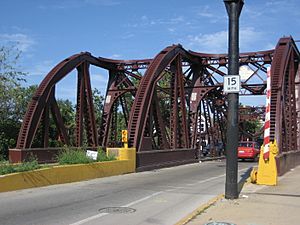Cortland Street Drawbridge facts for kids
Quick facts for kids Cortland Street Drawbridge |
|
|---|---|

Cortland Street Drawbridge 2007
|
|
| Coordinates | 41°55′01″N 87°39′51″W / 41.9170°N 87.6643°W |
| Carries | Motor vehicles, pedestrians and bicycles |
| Crosses | north branch of the Chicago River |
| Locale | Chicago, Illinois |
| Official name | Cortland Street Drawbridge |
| Characteristics | |
| Design | Chicago trunnion bascule bridge |
| Material | steel |
| Total length | 39 metres (128 ft) |
| History | |
| Designer | John Ernst Ericson and Edward Wilmann |
| Opened | 1902 |
| Designated: | July 24, 1991 |
The Cortland Street Drawbridge is a special type of bridge in Chicago. It was first called the Clybourn Place drawbridge. It crosses the Chicago River. John Ericson and Edward Wilmann designed it.
When it opened in 1902, it was the very first bridge of its kind in the United States. It's located on Chicago's north side. This bridge was a big step forward for how movable bridges were built. It became the model for more than 50 other bridges in Chicago. Because it was so important, it was named a Civil Engineering Landmark in 1981. It also became a Chicago Landmark in 1991.
How the Bridge Works
Chicago engineers are famous for designing bridges like this one. This type of bridge is called a "trunnion bascule." It has two main parts, called "leaves," that can be lifted.
These leaves pivot, or turn, on large bearings called "trunnions." Big weights, called "counterweights," help balance the leaves. This makes it easier to lift them up. The word bascule comes from a French word meaning seesaw. This is because the bridge moves like a seesaw.
On this bridge, you can see the gears that move it. They are on the curved parts at each end of the bridge. This is different from most other bascule bridges in Chicago.
History of the Bridge
The Cortland Street Drawbridge was built under the direction of Mayor Carter Harrison, Jr.. Frederick W. Block, who was in charge of public works, also helped supervise the project.
This is actually the second bridge built in this spot. The first one was a "swing bridge." That bridge had a support in the middle of the river. The new bascule bridge removed the need for that middle support. This made more room for boats to pass through the river.
Today, the bridge's moving parts are still there. However, the bridge no longer opens. Its leaves are now clamped together.
The bridge was once used by streetcars. These streetcars were part of Line 73-Armitage Avenue. They crossed the bridge until February 25, 1951. The next day, the bridge closed for repairs. Buses replaced the streetcars east of the bridge. Later, the entire streetcar line was stopped in June.
Electric trolley buses also crossed the bridge. They started on February 1, 1953. They replaced the motor buses on route 73. Trolley buses ran until October 15, 1966. After that, the route switched to diesel buses.
Today, the Cortland Street Bridge is used by cars, people walking, and people riding bicycles.

